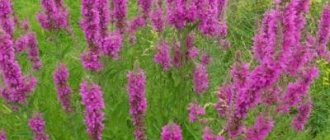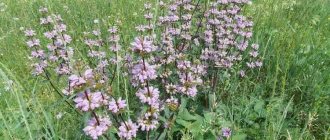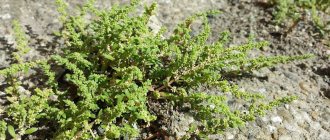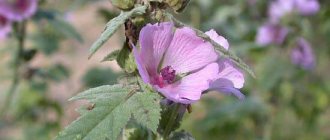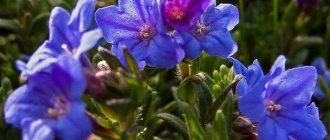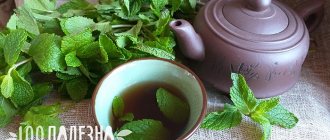Derbennikova (lat. Lythraceae) is a family of plants from the order Myrtaceae (lat. Myrtales), which includes the genus Derbennik (lat. Lythrum). Its representatives are used for different purposes: some are grown for beautiful flowers, others are used to prepare medicinal products or obtain dyes. Plants have existed on Earth for a long time. Scientists have discovered fossilized fruits, leaves, and pollen. The oldest find is seeds from Cretaceous deposits in Mexico and Paleogene deposits in Southern England.
Variety of species
Most species (35 in total) are herbaceous annuals or perennials, common in temperate regions. Rarely and only in the tropics are lignified loosestrife found: shrubs and trees with four-ribed young branches.
The most famous species is Lawsonia inermis, which produces a natural dye - henna. In Russia, the genus is represented by two species: loosestrife (Latin: Lythrum salicaria) and loosestrife (Latin: Lythrum virgatum). The first grows everywhere except the Arctic, and is known as a honey plant, an ornamental and medicinal plant.
The healing properties of loosestrife in folk medicine
Merlin is an excellent honey plant with long flowering. However, its appearance attracts not only bees; the inflorescences themselves, collected from small purple stars, are quite decorative, so the plant is used for landscaping. Since ancient times, its special properties have been used in medicine: weeping grass is a medicine for various “female” diseases, inflammations, bruises, skin irritations, and poisoning.
Loosestrife is used in decoctions or compresses; it is a good tonic when used externally (for example, in the form of strengthening baths). All these procedures can be done in the summer, when the bushes are covered with flowers. The rest of the time, dried stems, roots and leaves are used. As for magical use, loosestrife is prepared for it on one single night - on Ivan Kupala.
Loosestrife: distribution and description
Lythrum salicaria is distributed in Australia, North Africa, and Eurasia (with the exception of the central and southeastern parts). In North America it is a neophyte.
Often found in damp places: reed thickets, swamps and ditches, on the banks of lakes, ponds, rivers, streams, canals. The second name is weeping grass, since the droplets of excess water secreted by the leaves resemble tears.
The plant is thermophilic, prefers lowlands, but can also be found in the mountains at medium altitudes. It likes soils that are moist or variable-moist, temporarily flooded, and rich in nutrients, such as podzolic-gley soils.
Falling leaves are often opposite, less often alternate, arranged spirally or whorled. The leaf blades are simple, with pinnate venation and a predominantly entire margin. Stipules are small or absent. Flowers up to 1 cm in diameter, star-shaped, bright purple. They form long spike-shaped inflorescences.
The fruits of most specimens are capsules about 3 mm long. When ripe, they open and many seeds spill out. Some loosestrife produce berry-like fruits, partially or completely wrapped in tepals.
Description of weeping grass
Loosestrife is a herbaceous plant common in many regions.
You can meet it in the wild in damp, bright places: in water meadows, along the banks of lakes and rivers. The herb loosestrife reaches a height of up to 0.6 m. The stem is erect with a panicle of bright purple flowers. Flowering begins in early summer, the fruits ripen before autumn.
The beneficial properties of the plant are not limited to medicinal ones. Plakun rhizomes are used for processing fishing gear and tanning leather.
Chemical composition
The different parts contain:
- glycoside salikarin;
- pectin;
- alkaloids;
- resins;
- essential oil;
- a lot of tannins. In leaves and flowers these are predominantly gallotannins;
- acids: gallic, ellagic, p-coumaric and traces of chlorogenic;
- flavonoids: orientin, vitexin, isovitexin, isoorientin. C-flavonoids are found mainly in the leaves, traces in the petals;
- anthocyanins: 3.5 malvidin diglycoside, in small quantities - cyanidin 3-galactoside.
Beneficial features
In times of famine, people ate young shoots, leaves and stems instead of vegetables. Since loosestrife contains tannins (from 9% - root, to 14% - flowers), already in the 16th century leather, wood and ropes were soaked in its juice to prevent rapid rotting. Red dye, which was obtained from a perennial, was used to color sugar.
Since ancient times, plakun grass has been used to treat various diseases. In the book of the ancient Roman writer Pliny the Elder, it is mentioned as a remedy for eczema. The ancient Greeks, on the advice of the military doctor and pharmacologist Dioscorides, used it for hemoptysis and dysentery.
Now supporters of traditional medicine recommend a decoction of the roots for diarrhea, bleeding, and dysentery. Because the perennial is gentle, it is suitable for small children.
In the 19th century, the herb was used during cholera epidemics. Previously, it was also used to treat typhus. It has strong bactericidal, astringent, hemostatic, and diuretic properties. The plant helps with excessive menstrual bleeding, and in powder form - with severe nasal bleeding.
Herbal tea can stop even minor internal bleeding, but you should not experiment with it. If such a problem occurs, you should immediately consult a doctor.
In a study on the nutrition of rural populations in the Mediterranean region, it was found that the herb prevents the development of type II diabetes. In case of an existing disease, it is used in the form of tea or tincture as an additional remedy to the main treatment, since it slightly reduces glucose levels.
Contraindications for use: high blood clotting, blood pressure instability, allergies.
Restrictions and contraindications
When treating, it is necessary to take into account the contraindications of merlin - in some cases it can cause harm to the body. It is not recommended to use the plant:
- during pregnancy;
- during lactation;
- with hypotension;
- with a tendency to constipation;
- for varicose veins and thrombophlebitis;
- with increased blood clotting;
- with atherosclerosis;
- for individual allergies.
For inflammation of the intestines and stomach, loosestrife is taken with caution and with the permission of a doctor. Do not offer grass to children under 12 years of age.
Recipes and doses
- To make tea, take a handful of dried, crushed flowers. Pour in a liter of boiling water. Cover the container and leave for 30 minutes. For persistent diarrhea and abdominal pain, drink 4-5 cups of the drink per day.
- To make a decoction, pour 2 handfuls of dry herbs with cold water. Bring to a boil and simmer for 20-30 minutes over medium heat. Or pour 1 tsp. dried roots 200 ml of water and bring to a boil. Leave on the stove for 5 minutes, then remove and let the broth brew for 1 hour.
Indications for use
All parts of the merlin - flowers, seeds, leaves, stems and rhizomes - have medicinal properties. Plakun herb is widely used in homeopathy; preparations based on it are used as an antibacterial, tonic, restorative, and hemostatic agent. In addition, the plant has an antibacterial effect against gram-negative bacteria. Also, the recruiter is the main or one of the active ingredients of various medications.
The use of loosestrife is recommended for:
- Colds;
- Lung diseases;
- Diseases of the upper respiratory tract;
- Diarrhea;
- General weakness;
- Headache;
- Gastralgia;
- Colic;
- Dysentery;
- Fever;
- Nervous disorders;
- Noise in the head;
- Increased excitability, especially in children;
- Irritability;
- Toxicosis of pregnant women;
- Gastroptosis;
- Chronic catarrh of the stomach and intestines;
- Hemorrhoids;
- Typha;
- Dysentery;
- Rheumatism;
- Menorrhagia;
- Epilepsy;
- Diseases of the gums and teeth;
- Some cardiovascular diseases;
- Chronic inflammation of the intestinal mucosa;
- Diseases of the genital area, including uterine bleeding;
- Venereal diseases;
- Bites of encephalitic ticks, snakes and rabid animals;
- Schizophrenia.
Fresh leaves of the plant, crushed to a mushy state, can be used to treat bruises, wounds, felons, abrasions, cuts, eczema and varicose ulcers (including bleeding ones), as well as various dermatological diseases, including lichen.
Tea from derbennik is good for insomnia, depression, restless sleep, hysteria, general weakness and just a bad mood.
For sleep disturbances, including insomnia, and the sensation of noise in the head, traditional medicine suggests placing dry loosestrife herb sewn into a fabric bag under the pillow.
Calming baths with the addition of a decoction or infusion of plakun-herb are useful for children who are easily excitable, restless and suffer from convulsions. For general weakness, such baths are also recommended for adults.
Women have long used loosestrife for leucorrhoea, heavy menstruation and various sexually transmitted infections, including sexually transmitted diseases.
A decoction of the roots of the plant is used for convulsions, diseases of the upper respiratory tract, headaches, and it also helps with toxicosis in pregnant women. An infusion from the aerial part of the herb improves the patient's condition with rheumatism, prostatitis, diseases of the gastrointestinal tract, nervousness, hemorrhoids and epilepsy.
The tannins contained in the plant weaken the negative effects of alkaloids and heavy metal salts, and polyphenols help with venous insufficiency.
You can rinse your mouth with a decoction of loosestrife for gumboil, stomatitis and mouth ulcers.
Plakun grass is able to quickly and quite effectively remove toxins and poisons from the body, which is why it has been used for a long time for bites from rabid animals and snakes. The same property of loosestrife is used for food poisoning and alcohol intoxication. And when bitten by encephalitis ticks, the plant counteracts the development of cerebral edema.
Growing loosestrife
Weeping grass prefers sunny places, but grows normally in partial shade. It blooms poorly in the shade. Even more than light, the loosestrife plant needs water. It feels best in constantly wet flower beds, on the banks of a pond or stream, near a well and in shallow water.
In flower beds, the loosestrife flower “gets along well” with burnet, monarda, and sapling. On the shore of the reservoir there are beautiful companions of weeping grass - snakeweed, angustifolia cattail, and false calamus iris. Because it purifies water, it is often planted in the regeneration area of swimming ponds.
In summer, bright inflorescences look beautiful, and in autumn, the garden is decorated with dry stems with seed pods. The flowers are not poisonous. Direct contact with them is not dangerous for children and animals.
Planting in the ground
Merlin can be planted all year round, except during the cold winter period. The best time is from March to April or from September to October. Between the holes, leave a distance of 30-40 cm when planting seedlings and 50 cm for parts of rhizomes, that is, per 1 square. m will account for approximately 4-5 copies.
Make the planting holes large enough to fit a mixture of soil and peat around the earthen ball. Having inserted the weeping grass into the hole, fill it with soil, press it down well and water it generously. A layer of shavings distributed around the plants prevents the rapid evaporation of moisture.
Sow the seeds in March in containers filled with soil, which are then covered with polyethylene. For germination, a temperature of at least +15 °C is required.
Growing in water
If you want loosestrife to grow in shallow water in a pond, it is best to plant it between May and June. Use a mesh pot or a special basket for this. It is important that the container has the appropriate dimensions, since weeping grass reaches significant sizes in water.
Landing sequence:
- Line the basket with jute;
- Fill with special soil;
- Insert the plant and fill the hole with soil;
- Add fertilizer in balls;
- Cover the fertilizer with jute, add straw and a layer of pebbles;
- Lower the basket to a depth of no more than 20 cm.
The soil
Weeping grass is unpretentious and easy to care for. In nutrient-rich, moist, low-alkaline and even clay soil, it reaches a height of up to 1.5 m. It can be planted in ordinary garden soil mixed with compost and mulch, which absorbs water and then gradually releases it.
Loosestrifes really like soil with a high content of humus and nutrients.
Care
The main thing is to maintain humidity. Make sure the soil never dries out completely. Even if the perennial receives enough moisture, it is important to water it regularly.
During the height of summer, do this several times a day using settled tap, rain or pond water. Less moisture is required if flowers are grown in beds filled with heavy clay soil.
Every spring it is enough to apply basic fertilizer at the rate of 2 liters per 1 square meter. m. An alternative is mineral fertilizer from a specialty store or organic fertilizer, such as horn shavings.
Fermented infusion of nettle or compost that is added to the soil is also suitable. The only important condition is that the product should not contain a lot of nitrogen.
Diseases and pests
Since various parts contain tannins and essential oils, snails and plant lice avoid it. Infection with other pests is rare. The only big problem is leaf spotting. They turn brown and dry out.
The development of the disease is promoted by too high soil moisture and rain. If several leaves are damaged, they are simply removed. When the infection is severe, the affected perennials are destroyed.
Reproduction
The grass produces many seeds. If you need to limit its spread or get one variety, cut off the flower stalks immediately after flowering. Otherwise, the perennial will fill the entire garden.
Vegetative propagation is possible: by rhizomes and cuttings. When using this method, the offspring are completely identical to the mother plant. The rhizome is carefully removed from the ground and cut into pieces 10 to 15 centimeters long. The best time for division is spring, as soon as the first shoots appear, or summer, when flowering has ended.
Too large bushes are divided in early spring. It is recommended to shorten the roots before planting. It is enough to update the merlin every 5 years. If you refuse to divide, the perennial will grow in one place for 10-20 years and reach large sizes.
The bushes are removed from the pond in May and divided into small ones. It is better not to return some of them to the water, but to plant them in the garden. Otherwise, the pond will become overgrown.
Features of wintering
Loosestrife is a winter-hardy perennial that does not need special protection. But before the onset of severe winter, the plants standing in the pond should be pulled out and taken to a room protected from frost. They are placed, for example, in buckets and placed in the basement, garage or stairwell. Or the pots are pulled out of the water before the first frost and weeding grass is planted in the ground in the garden.
Merlin blooms all summer. If it begins to look worse (loses its decorative effect), it is cut off. Then side shoots are formed, which usually also bloom.
How to preserve medicinal properties: rules for collection and storage
The weeping grass, loosestrife, is widespread in the wild, preferring sunny places with well-moistened soil. Proper collection of raw materials and compliance with storage rules allow you to preserve all valuable substances.
Collection rules
The right time for harvesting the above-ground part of medicinal raw materials is June and July - the time when the leaves have already blossomed and flowering has not yet begun. They begin harvesting roots in the fall. To do this, they are dug up and dried well.
You can do this in two ways:
- Laying out in the shade on paper.
- By hanging bundles of several roots tied together.
Not only dried, but also fresh herbs can be used for medicinal purposes, immediately after collection.
Storage Features
It is best to store herbs in areas with good ventilation, dry air, and away from direct sunlight. Fabric bags are suitable for storage.
The medicinal properties of collected loosestrife are preserved for no more than two years, provided that all rules of collection, preparation and storage are observed.
